10 DE Weapons, MASERS/LASERS
By Randall W. Mai, Kansas State University
STUDENT OBJECTIVES:
- A look at the simple LASER Pointer and how sweet it is from a drone’s POV.
- Peruse a short history of LASER-based technology’s origin, functioning, and applications.
- Develop an understanding of the many types of LASER weapons and their capabilities of affecting a target.
- Summarize the technical capacities of LASERS from Nielson’s Chapter 3). (Nielsen, 1994)
- Examine ways LASERS could be attached to an sUAV and larger UAVs and what damage could be expected from their use.
- Observe the political implications of LASERS
- Think asymmetrically about how to defeat swarming drones with LASER.
LASER POINTER
We are familiar with light, a special case of electromagnetic radiation (EMR). Other examples of EMRs include radio waves, x-rays, and microwaves. EMR propagates through space from its source as a wave, much as water propagates through a pond from its source (perhaps a rock thrown into the pond). Chapters 8 & 9 of this textbook cover the theory behind DEW.
A LASER is fundamentally nothing more than a device that can produce an intense or highly energetic light beam.
Perhaps the simplest form of LASER that our students see in many classrooms is the LASER pointer. There is a dark side to these educational devices – blinding commercial pilots.
Laser pointers can be cool toys, posing a serious blinding risk. Figures 10.01 & Figure 10.02 show the view from a pilot’s perspective when someone shines a light on an airplane. We put pilots in charge of transporting hundreds of people in an airplane safely to a destination; surely, the last thing you want when you are on the plane is a blind pilot. (laser-pointers-blind-pilots, 2015)
Figures 10.01 & 10.02 LASER Pointers – Pilot View
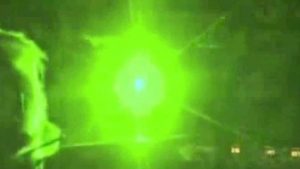

Source: (laser-pointers-blind-pilots, 2015)
CAN A LASER POINTER BE USED TO BRING DOWN A DRONE?
The interesting question is, “can a LASER pointer be used to bring down a drone rather than cut through it” (Can a LASER pointer bring down a drone? 2022)
Figure 10.00 LASER Pointer (small)

Source: (Will-a-Laser-Pointer-Bring-Down-a-Drone-Answered, 2022)
Yes, high-powered lasers could bring down a drone. Laser rays create heat and can cause the outer body of the drone to melt and damage the drone’s internal wiring. Standard laser pointers can interfere with the drone’s sensors and emit bright lights, which can blind the camera, thus obstructing the operator’s view, potentially causing a crash. (Can a LASER pointer bring down a drone? , 2022)
Laser Pointers are pen-like devices that project a narrow beam of light. All the projected light waves feature similar wavelengths, and they travel together in a phase. Laser light does not spread much, concentrating its energy on a small area. This light concentration is responsible for the heat up and field of view obstruction mentioned above.
INFRARED INTERFERENCE
Drones are flown at low altitudes, creating the need for sensors. This is why most drones feature infrared sensors to help them accurately judge the surface below them. The drone relies on this for auto-landing and obstacle avoidance features. However, the functionality of the downward infrared sensors can be interfered with by laser pointers. They cause the image of the surface below the drone to be blurry. This means the drone cannot reliably sense the surfaces or potential obstacles in its path, leading to a crash.
BRIGHT LIGHTS
A drone operator relies on the drone’s camera to get a clear idea of the drone’s flight path when flying. Lasers can inhibit the vision of the drone pilot if they emit their bright narrow beams of light to blind the camera. As a result, the drone pilot’s view through the camera feed will be disrupted. This might further cause the pilot to lose control of the drone, leading to a collision or crash.
HEAT DAMAGE
Every laser pointer carries some heat, whether it’s an ordinary or Industrial-grade laser, due to the direct focus of the light beam. Therefore, there will be heat generation when it comes into contact with the surface of a drone.
If the heat accumulates for long enough, it can melt the plastic housing of the drone, thus revealing and damaging its internal wiring. Some plastic and metal parts can even come loose and fall off. This might lead to erratic behavior or a crash landing.
IS TAKING A DRONE DOWN WITH A LASER ILLEGAL?
Yes. According to the FAA and various state laws, taking a drone down with a laser is illegal. Drones are considered aircraft, and therefore you can be jailed or fined if you use lasers to bring a drone down. Using a laser pointer interferes with the drone pilot’s ability to fly and the drone’s communication systems. This damages someone else’s property, but it can also lead to other potentially harmful events such as crash landing on people or property. Here are some of the defensive systems.[1]
RAFAEL DRONE DOME
Rafael Advanced Defense Systems developed the Rafael Drone Dome system. It is used to secure the airspace by identifying, tracking, and bringing down suspicious drones. Rafael Drone Dome is an all-weather laser pointer that cannot be evaded even by rapidly moving drones. Once it has identified a drone, it follows its trajectory and emits laser beams. Additionally, this laser pointer can bring down multiple drones because it emits very high energy. It also blocks the drone’s remote control’s command and signal. This laser pointer also jams video transmission from the aircraft to the pilot. (Rafael Drome Dome – c-uas-counter-unmanned-aircraft-systems/, 2022)
RAYTHEON DRONE-KILLING LASER
The Raytheon laser often brings down suspicious drones in the United States. Being a high-energy laser beam machine, Raytheon can target many drones at a go. Once it targets a drone, it can retarget another one with its speed of light engagement. It is highly effective because it detects, tracks, and shoots down drones using a multi-spectral targeting system.
Several authorities of defense and aviation are using Raytheon Drone-killing lasers to counter drone threats. The good side of this laser pointer is that it can be positioned anywhere or even mounted on a vehicle. (raytheon-drone-killing-laser, 2022)
ATHENA
This advanced high-energy laser beam can bring down both rotary drones and those with fixed wings. These laser pointers do not explode drones; instead, they function by burning the outer parts of the drone. It disables the device or makes it prone to breakup. The Athena laser system has come in handy in bringing down drones flying over commercial or defense airspace with malicious intent. (Airforce Technology, 2022)
EVASIVE MEASURES USED BY DRONES
A laser pointer can damage a drone regardless of how powerful it is. Fortunately, technology has brought protective laser pointers to help drones protect themselves from harmful ones. These evasive lasers are mounted on drones.
This might sound counter-intuitive, but the evasive laser pointers are incredible. The drone protects laser works by detecting a laser beam coming towards it, taking note of its wavelength, power, and impulse. After that, the laser projection system mounted on the drone releases its laser pointers and counterattacks the incoming laser beam. The counter protective laser pointer uses two ways to protect the drone. First, it causes the attacking laser pointer to go astray while convincing the attackers that they have hit their target. Second, there will be a production of light burst once it directly hits the incoming beam. This again will convince the attacker that the targeted drone has been hit.
WHICH LASER COLORS ARE THE MOST DANGEROUS AND WHY?
According to the FAA, blue and violet are the most dangerous laser colors to the human eye. This is because the human eye is initially less sensitive to them. Unlike a green or red laser, the eyes take time before reacting to them. A drone operator might take longer before blinking or turning away from blue or violet lasers, thus posing a greater injury risk.
WHY ARE BLUE LASER POINTERS MORE DANGEROUS?
The easy absorption of blue lasers by retina pigments is the most dangerous. Once absorbed, they damage the eye by burning the macula, a highly sensitive retina center.
WHAT LASER POINTER COLOR IS THE MOST POWERFUL?
In terms of brightness, green is the most powerful laser color. See Figure 10.01. When compared with other colors, it will always outshine them. This is because the human eye’s sensitivity increases in the green region of the spectrum. Colors like red have longer wavelengths, thus decreasing the eye’s sensitivity to them.
CLASSES OF LASER POINTERS
Laser pointers are classified according to their damage-causing potential. There are four classes of laser pointers, as discussed below.
Class 1 Laser Pointers
The laser pointers in this category are safe and won’t cause eye damage to operators. They don’t have much light, and therefore there are no hazardous effects even when exposed to them. Class 1 lasers are exempted from control measures.
Class 2 Laser Pointers
These laser pointers have low power, and you can see the radiation they emit. Although they are more powerful than Class 1 lasers, they are less harmful to the eyes and will not cause any harm to the skin. You can be safe from them by blinking your eyes or turning away from their light.
Class 3 Laser Pointers
This class consists of two levels – class 3B and class 3R. 3R is harmful to the eyes, and most laser pointers at this level are powerful. Class 3B can severely damage your eyes, especially if you get exposed to them for long. Lasers in this category are used in research and physiotherapy treatments. 3B lasers should not be used in public.
Class 4 Laser Pointers
Lasers in this category are highly powered and feature a power output of more than 500 mW. They are hazardous to the eyes and skin. They can also cause fire hazards, and therefore you should enclose their laser beam path.
LASER Pointer Summary
A laser pointer can bring a drone down, especially the high-powered ones. They heat the drone, damage its wiring system, and interfere with the pilot’s field of view. However, using a laser pointer to interfere with a drone is illegal, and you can be imprisoned or pay a hefty penalty for the crime. It is, therefore, not wise to use a laser pointer on a drone. (Can a LASER pointer bring down a drone? , 2022)
So, where did the concept of LASER develop from?
A LITTLE HISTORY
The word LASER is an acronym for Light Amplification Stimulated Emission of Radiation. Theodore Maiman was credited with the building of the first operating LASER. Before Maiman’s discovery, Charles Townes and Jim Gordon were credited with the invention of the MASER. It is an acronym as well; Microwave Amplification Stimulated Emission of Radiation.
Immediately after the Second World War, physicists in several laboratories began working on the microwave spectroscopy of molecules. The field grew rapidly but was soon given up by industrial labs as they saw no useful applications for the work and moved to universities at that time. (Townes C. H., 2004)
- – Almost everyone in the field wanted to obtain shorter waves because the wealth of molecular lines and their Intensity of absorption increased rapidly as one moved from centimeter to millimeter wavelengths and then down into submillimeter or infrared wavelengths. Harmonic generation with electronic equipment could achieve millimeter wavelengths but not the submillimeter range. (Townes C. H., 2004) At Columbia University, New York, several years of hard work were spent looking for ways to obtain shorter waves without much success. The US Navy was also interested in short waves. In the early 1950, Townes was asked to form a national committee to search for ways of extending radar technology into the shorter wavelength region. Many centers and laboratories in the United States and Europe were looked at for good ideas for producing short waves. None surfaced. (Townes C. H., 2004)
High temperatures would be needed to excite sufficient numbers of molecules. Too high, and the molecules would all disassociate. Townes then assumed that not all molecules are in thermal equilibrium. He assumed that they would have no limit to their potential radiation intensity. (Townes C. H., 2004)
Townes decided to test the idea in his lab by first making an oscillator at longer centimeter wavelengths, where ammonia has intense resonances. If successful, he could then push into the submillimeter or infrared region. Townes looked for a student who might give it a try, and before long, Jim Gordon, an outstanding student, turned up. With postdoc Herbert Zeiger, they were set to start. Two years later, Gordon and Zeiger had still not obtained oscillation. At that time, Polycarp Kusch, the departmental chairman, and Isidor Isaac Rabi, his predecessor, went into Charles Townes’s office and convinced him that the experiment would not work. (Townes C. H., 2004)
Figure 10.1: Charles Townes (left) and Jim Gordon with a beam type MASER.

Source: (Townes C. H., 2004)
Two months later, Gordon dashed into the classroom and declared: “it’s working.” The whole class left to go to the lab to witness the demonstration. The new kind of oscillator was named a MASER for microwave amplification by stimulated emission of radiation.
Most scientists didn’t believe the MASER idea could be extended to such short wavelengths because of the much higher decay rate of excited atoms or molecules as the wavelength became shorter. By the fall of 1957, Towns had figured out just how an optical MASER (LASER) could be built. On a consulting visit to Bell Labs, Townes ran into Schawlow again and told him about his ideas for an optical MASER. Townes planned to optically excite atomic gas, have it radiated by stimulated emission, and use a cavity as a resonator. He wasn’t completely happy with the cavity, as it would probably have multiple mode oscillations. Schawlow said, “Oh, I’ve also been wondering if that could be done,” and suggested using two parallel mirrors, a Fabry–Perot, as a resonator. After a short delay, while Bell Labs fixed up an appropriate patent, we published our ideas in 1958. There was immediate excitement. The MASER had convinced the industry that this was a valuable field, and very quickly, there were many efforts to build a LASER. The field of quantum electronics had begun. (Townes C. H., 2004)
Theodore Maiman was the first individual to build the first operating LASER in 1960 physically. Many applications have been produced from his operating LASER and are now part of our daily lives. (Townes, 2007) From medicine to communications, completely discoveries have been made. The remaining focus will be on Directed Energy Weapons (DEW), with Drones as the vehicle to deliver applications that stretch from ground-based LASERs to outer space systems.
Figure 10.2: Theodore Maiman

Source: (Townes, 2007)
Stimulated emission of radiation, the critical process behind the LASER, was first recognized by Albert Einstein as early as 1918. But it was only in 1951 that its use for practical amplification of electromagnetic waves was recognized, and in 1954 the first such device, the MASER operating at centimeter wavelengths, was constructed. (Townes, 2007)
LASERs remained at the backwaters of scientific optical endeavors as a novelty for many years; however, they are now in almost every important aspect of life. Communications, medicine, measurement, optics, and many electronics rely on the special light emitted by LASERs. The characteristic of coherence of LASER light is what makes it very special. LASER light has three distinct characteristics:
1) Monochromatic, it is produced in one wavelength/color. White light is the opposite; it is a blend of wavelengths/colors.
2) It is directional instead of multidirectional like a light bulb, where light comes from every angle.
3) LASER light is Coherent. That is to say, the wavelengths of light are in phase in 3-dimensional space and time.
Figure 10.3: LASER Coherence
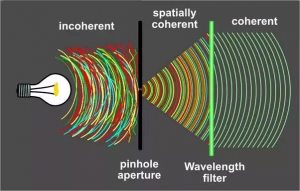
Source: (Laser Coherence, 2022)
Since discovering the ability to raise various substances to radiate excited light-producing particles with the three main ingredients; monochromatic, spatially directional, and Coherent, many uses have been developed. LASERs uses are becoming more, and the ways to produce LASER light are becoming better as the electronics that produce them get better.[2]
What exactly is a LASER? A LASER is a device that emits light of identical wavelengths, known as coherent light, in a very narrow beam. The LASER beam’s energy can vary widely, from the low power used in LASER pointers to the high heat used to cut metal. (Monte, 2021) Figure 10.3. [3]
MILITARY INTERESTS
By 1962 the US military was spending about $50 million on LASER development. With all this money flowing in, the US military had certain expectations about a LASER that would serve as a weapon; however, LASERs at the time were unable to emit sufficient energy levels to make a suitable weapon. By 1968 some experts concluded they had hit a wall. The engineering was extremely complicated, forcing them to question if they were trying to violate the LaWS of physics. (Monte, 2021) Unlike regular missile systems that explode, providing rather large fragments of material, LASER light particles are very small in terms of material and transfer lesser amounts of force. Even being propelled at the speed of light, these partials struggle to do much damage to materials that might even be reflective. In the 1970s, the military finally got a weapon—not the war of the Worlds weapon it wanted but a close combat LASER assault weapon (C-CLAW). (Monte, 2021) (Arkin, 1 May 1995) It could be used to blind enemy pilots, soldiers, and optical sensors from distances greater than a mile. Under the direction of the US Army, its development continued into the 1980s. A 1983 article in the Washington Post described its application: “The portable LASER beam would sweep back and forth across a battlefield blinding anyone who looked directly at it.” (Arkin, 1 May 1995) In testing, the C-CLAW could cause the eyes of laboratory animals to explode. Using this on humans, even in war, raised serious ethical questions. Since the Army’s LASER would not discriminate between human eyes and optical sensors, the world community, primarily through the United Nations, considered such blinding LASERs horrid. In many ways, blinding LASERs were similar to chemical weapons that could cause blindness, and the UN had already banned such weapons. As a rule, the UN seeks to ban weapons that cause “superfluous injuries and/or unnecessary suffering for little military purpose.” (Arkin, 1 May 1995)
By 1995, before their use in combat, the UN established the Protocol on Blinding LASER Weapons, Protocol IV to the 1980 Convention on Prohibitions or Restrictions on the Use of Certain Conventional Weapons, which prohibited the use of blinding LASERs in warfare and controlled their transfer to any state or non-state actor. The protocol went into force in 1998. (Multilateral-Weapons-Protocol-IV, 2019)
The Protocol on Blinding LASER Weapons has 108 parties (i.e., member states signatories to the treaty), including the United States, Russia, and China. Both China and Russia were early signatories, joining in 1998 and 1999, respectively, while the United States did not become a signatory until 2007. (Multilateral-Weapons-Protocol-IV, 2019) By 2007, other nations likely achieved similar LASER capabilities. With the prospect of a potential adversary using a blinding LASER on American forces, the leadership decided to become a signatory. [4]The Washington Post reported that the US Army’s only concern was “over the probable public reaction once the purpose of the weapon becomes known.” (Monte, 2021)
In the 1980s, research on directed-energy weapons intensified as Ronald Reagan’s administration established the Strategic Defense Initiative (SDI). The Atomic Heritage Foundation, a nonprofit organization dedicated to the preservation and interpretation of the Manhattan Project and the Atomic Age and its legacy, observed, “Reagan’s interest in anti-ballistic missile technology dated back to 1967 when, as governor of California, he paid a visit to physicist Edward Teller at the Lawrence Livermore National Laboratory. Reagan reportedly was very taken by Teller’s briefing on Directed Energy Weapons (DEWs), such as LASERs and microwaves. Teller argued that DEWs could potentially defend against a nuclear attack.” When Reagan won the presidency, he wanted a weapon to shoot down enemy missiles from space. He believed that SDI was a path to ridding the world of nuclear weapons. The Soviets were highly vocal opponents to the initiative, arguing that “SDI would pave the way for weaponizing space.” In response, Reagan suggested the United States might eventually share SDI with the Soviet Union, which in an earlier speech, he had described as an “evil empire.” (Monte, 2021) Given Reagan’s characterization of the USSR, the Soviets distrusted his administration and remained entrenched in their opposition to SDI. Other national leaders worried SDI would set off another arms race and make the Cold War even more dangerous.
Nonetheless, despite Soviet protests and shocked officials around the globe, the Reagan administration went forward with the research.
The press dubbed SDI “Star Wars,” based on the LASER-like weapons used in Star Wars, a popular science fiction movie. Much of the program’s development focused on two directed-energy weapons—X-ray LASERs and subatomic particle beams. (Subatomic particle beam weapons use high-energy subatomic particles to damage a target by disrupting its atomic and molecular structure). Once again, the power needed to supply such weapons proved prohibitive, and SDI floundered. In actuality, this was a good thing. The EMF pulse created by the weapons of SDI would knock out or disable the very electronics needed to track incoming ICBMs. (Monte, 2021)
As evident in the first GULF WAR, the US military eventually learned to use low-power LASERs to guide missiles to their targets and as range finders on its tanks. By 2006 the US military also used low-power LASERs to “dazzle” (i.e., cause temporary blindness) enemy combatants in Iraq. The dazzlers mounted on the American soldiers’ m-4 rifles provided a nonlethal way to stop drivers who attempted to run through checkpoints.
Figure 10.4: LASER Dazzler for M-4 rifle
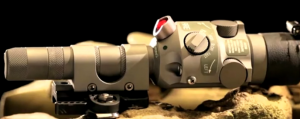
Source: (LASER Sight on M-4, 2022)
Figure 10.5: LASER Dazzler in operation
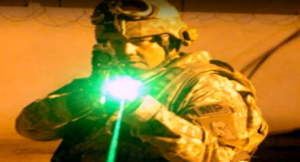
Source: (LASER Sight on M-4, 2022)
The dazzle effect can be defeated with proper goggles blocking the incoming wavelength. High-powered LASERS can be reflected with the use of proper surface coatings. Up to 90% of energy can be redirected. [5]
WEAPONIZING THE LASER
Weaponizing the LASER requires an enormous amount of power. Projecting light particles with no mass for all practical purposes must be accelerated to the speed of light and require huge amounts of energy to imply any force upon the desired object to be destroyed. However, technology is progressing. The guidance and control systems, built with integrated circuits, have shrunk in size, becoming more capable, and requiring less power. They follow Moore’s law, an observation named after Gordon Moore. (Monte, 2021)
Still, a LASER can have much of its power siphoned off within an atmosphere due to partials and gases that absorb much of the radiation. This can even affect coherence and diminish the ability of the LASER light to stay together, causing a pheromone called blooming.
Figure 10.6: Atmospheric influences
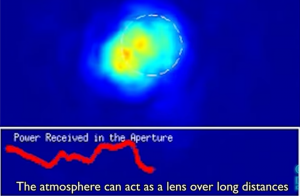
Source: (Atmospheric influences, 2022)
An atmosphere brings up an important point. Currently, Russia has claimed the successful testing of hypersonic missile systems capable of carrying nuclear weapons that travel thru the earth’s atmosphere. Recently, Russia invaded the country of Ukraine and is still engaged as of 04/03/2022. They have created destruction by aerial bombardment and artillery strikes. It has affected the civilian population and is very disturbing to western democracies. Ukrainian leadership has requested NATO impose a no-fly zone over their territory. Russian leadership implied it would consider nuclear weapons if NATO imposed a no-fly zone. Given the tensions in that region, the use of nuclear weapons carried by hypersonic missile systems capable of speeds plus Mach5 pose a unique set of problems for the western allies. The first thought is to have a counter weapons system capable of greater speeds to track and destroy such fast-moving targets. Militarily, the first such system to come to mind is the use of a LASER system. However, the weapons systems of high-powered LASERs encounter many problems. They are Power source, effective distance, weapons platform, delicate components, and cleanliness.
Figure 10.7: LASER platform mounted on Boeing 747

Source: (LASER platform mounted on Boeing 747, 2022)
The platform capable of carrying a LASER that could be used as a weapons system, such as the Boeing 747, would have to loiter over suspected targeted areas. An entire fleet would need to be deployed constantly to be effective against incoming hypersonic missiles.
MOORE’S LAW IMPLICATIONS
Moore’s law states the speed and capability of computers will double every two years, as the density of transistors doubles on an integrated circuit during the same period. Following Moore’s law, the guidance and control circuity had improved from 1980 to 2007 by more than eight thousand times. Integrated circuit manufacturers of commercial products, such as solid-state memories and microprocessors, had to plan their future products to fit Moore’s law. Failing to do so meant they would not be competitive. In a sense, Moore’s law became a self-fulling prophecy. In the last few years, though, some experts in integrated circuits claim that Moore’s law is reaching an end. The size of various features on advanced integrated circuits has shrunk to only a few atoms wide. Experts state that integrated circuits can no longer possibly follow Moore’s law. In one sense, they are correct. The ever-shrinking feature size in the integrated circuit industry is how companies could double the circuit density every two years.
However, Moore’s observation is a subset of a more encompassing law—namely, the law of accelerating returns. Ray Kurzweil published an essay describing it in 2001, stating, “An analysis of the history of technology shows that technological change is exponential, contrary to the common-sense ‘intuitive linear’ view.” By using the word “exponential,” Kurzweil refers to how technological change increases in a nonlinear fashion, similar to Moore’s law and its prediction that the speed and capability of computers will double every two years. That means such change improves 200 percent (relative to its initial ability). If it were linear, it would only grow 100 percent. (Kurzweil, 2020)
Technologists also discovered a crucial element to turn a LASER into a weapon; they pulsed the LASER to fire in discrete blasts timed in fractions of second intervals. This pulsing causes the target material’s surface to explode with each impact, allowing the plasma the LASER creates to dissipate. This technique requires less energy for the LASER to blast through an object while creating broader craters. In 2014 the US Navy installed the first-ever LASER weapon system (LaWS) on the USS Ponce, an afloat forward staging base, for field testing. After three months of testing in the Arabian Gulf, the navy reported that LaWS worked perfectly against low-end threats, such as small boats and drones. Following the completion of the tests, the navy authorized the commander of the Ponce to use LaWS as a defensive weapon. (USN, 2022) Until deploying LaWS, most lay public had never heard of the USS Ponce. Then news of its LASER weapon suddenly jolted the Ponce into the public eye. The Ponce, built-in 1966, began to light up the internet as one of the navy’s deadliest vessels. (Monte, 2021)
Figures 10.8 & 10.9: LASER Testing
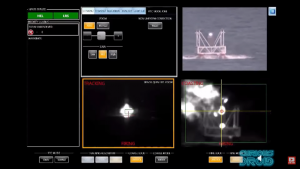
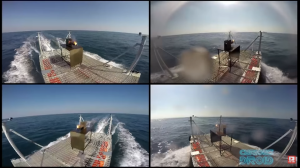
Source: (LASER Testing, 2022)
NANOTECHNOLOGY
Nanotechnology is science and engineering conducted at the level of atoms and molecules, typically resulting in feature sizes less than one-thousandth the diameter of a human hair. (Monte, 2021) Although the LASER weapon’s technology is secret, numerous articles argue that the rapid development of nanotechnologies over the last decade enabled significant internal component improvements of the solid-state LASER system, making it deployable as a weapon. Currently, the US military leads in developing Nano-weapons, defined as any weapons that exploit nanotechnology. (Monte, 2021)
The US government has been funneling tens of billions of dollars into weaponizing nanotechnology since it established the National Nanotechnology Initiative (NNI) in 2000. The NNI is a research and development initiative involving the nanotechnology-related activities of twenty-five federal agencies. Based on the law of accelerating returns, it is reasonable to conclude that well-funded nanotechnology, combined with well-funded LASER technology, enabled LASERs to evolve from dazzlers in 2007 to directed-energy weapons in 2014. (Monte, 2021) The navy’s new LASER weapon had a dial-in capability. Set to dazzle, it could disable an adversary’s drone or boat, allowing its recovery for examination. Alternatively, at full power, it could destroy a drone or boat. (Monte, 2021)
Figure 10.10: LASER weapon Destroying UAV
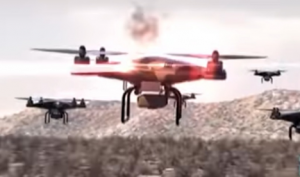
Source: (LASER weapon Destroying UAV, 2022)
FAIR-WEATHER LASERS
Are High-Energy LASERs Fair-Weather Weapons? You may have heard the phrase “fair-weather friend,” which refers to a person who will stop being your friend in difficult times. Such a person is not a real friend; the type you can count on when needed. The US military has a name for weapons that only work when weather conditions are right, such as ” fair-weather weapons on a sunny day.” The US military does not deploy them because it never knows what weather it will encounter during a conflict. Weapons need to work under a broad spectrum of weather conditions, and the US military needs to know it can count on its armaments to work regardless of the elements. (Monte, 2021)
POWER ISSUES
LASER interacting with matter affects a LASER. Light acts as a wave; however, it is subject to refraction, diffraction, and all those effects while it propagates, but when it’s finally absorbed or scattered from a target, it needs to be treated as a stream of tiny little bullets. How small are the bullets? Quantum theory tells us that light of frequency v is absorbed in units of hv, where h is a constant (Planck’s constant), equal to 6.63 X 10-34 Joule seconds. This means that for a red light with a wavelength of about 0.7µm and a frequency of about 4 X 1014 Hz, the energy of a single bullet is hv = 3 X 10-19 Joules. This is a very small number. (Nielson, 1994) [6]
When compared to the criterion of 10,000 Joules as the zero-order to create damage, we can see how much power a weapons-grade LASER requires. LASER weapons must interact with surface materials. If the LASER cannot interact with a target material, no positive destructive effect will occur. Power is part of the LASER’s calculus to be effectively destructive.
The current F-22, F-35, and F-15 are upgraded to increase kW output. This could be used as energy-related weapons are retrofitted to those airframes. Also, as the 6th Generation fighter jet fleet comes online, LASERs will benefit from increased kW outputs.
“[The] peak value of the average intensity [of a LASER beam] can be astonishingly affected by atmospheric turbulence.” Therefore, the LASER has the potential to be a fair-weather weapon. If that were the case regarding LaWS,[7] the US military would not deploy it; consequently, we can reasonably assume the US military has worked to mitigate the effects of weather on its LASER weapons. As David Stoudt, writing for Booz Allen Hamilton, observed, “The HEL [high-energy LASER] weapon community has been actively working to mitigate the effects of these conditions for many years, and in the case of atmospheric turbulence, has made significant advances using adaptive optics.” Without going into the details, most of which are classified, the US military’s LASER can function in multiple atmospheric conditions. As Stoud reports, this capability has enabled the navy to use the LASER in another critical way: “The US Navy placed a HEL weapon on the USS. Ponce, where in addition to its capability as a weapon, it was used almost continuously as a reflecting telescope [a telescope that uses mirrors] that allowed visibility of distances greater than 10 kilometers [about six miles] and penetrating things like smoke, haze, and even light fog.” (USN, 2022) The US Navy is silent on what atmospheric conditions would degrade the effectiveness of the LaWS; however, based on the Booz Allen Hamilton report, it has found solutions to address much of the problem and continues to work on the remainder. In the author’s opinion, LaWS is an all-weather weapon capable of destroying targets in smoke, haze, rain, and fog. (Monte, 2021)
Figure 10.11: HEL (high energy LASER) USS Ponce

Source: (HEL High Energy LASER USS Ponce, 2022)
FOR THE GEEKS
(Nielsen, 1994) Chapter 3 presents 124 pages (pp 81 – 205) of technical details about the propagation of LASER energy in a vacuum and atmosphere on its way to a target. The authors will summarize his main ideas without mathematical derivations: [8]
- LASERS are intense sources of electromagnetic radiation, with wavelengths from about 10 to 0.4 μm and frequencies from about 3 X 1013 to 8 X 1014 Hz.
- An index of refraction n characterizes the materials with which LASERS might interact, and an attenuation coefficient, K. When light passes regions of different n, it is bent according to the law of refraction. This can occur deliberately in lenses or inadvertently since fluctuations in n accompany density fluctuations in the atmosphere. When light propagates a distance z through a region whose attenuation coefficient is K, its Intensity is decreased by a factor exp (-Kz) [9]
- A LASER of wavelength λ emerging from the aperture of diameter, D, can propagate a distance of the order of D2 / λ as a collimated beam. Beyond this distance, it will diverge at an angle of Ø ~ λ / D through diffraction.
- Decreases in Intensity resulting from both diffraction and attenuation will reduce the fraction of a beam’s energy that can be brought to bear on a target. Beam parameters that may be adjusted to compensate for these effects and deliver damaging intensities to the target include energy, pulse width, wavelength, and the beam’s diameter.
- In the atmosphere, K is highly wavelength dependent. If a beam becomes too intense, free electrons will multiply, and air will break down, forming an ionized plasma that will absorb the beam. They can reverse and detonate the beam. In the atmosphere, n can vary with turbulence. Other effects are beam expansion ( thermal blooming) or bending.
- When LASER light encounters a target, a fraction of the light is absorbed in the target surface and appears as heat. The criterion establishes thresholds for melting and vaporization that energy is deposited so rapidly that it cannot be carried away within the pulse width of the LASER.
- Targets can be damaged either through erosion which results from melting or vaporization (thermal damage) or through the momentum transferred to the target surface by the evolving vapor jet (mechanical damage) (Nielsen, 1994)[10]
NEW THREATS
The threats the United States now faces are more complex than those during the Cold War were. During that period, the United States had one capable adversary, the Soviet Union. We avoided nuclear war because the American and Soviet Leadership understood the doctrine of mutually assured destruction. Now the United States faces four capable adversaries. With the rise of new weapons (Drones and Hypersonic Missile Systems), radical ideologies, and swarming tactics, the doctrine of MAD (Mutually Assured Destruction) may not deter nuclear war. (Monte, 2021) (countering-the-uas-challenge, 2022) Swarming is a military tactic borrowed from nature. For example, when bees attack, they attack in swarms. In applying this military tactic to sink a US aircraft carrier, an adversary is likely to attempt to overwhelm the carrier group’s defenses by attacking it, for example, with large numbers of missiles. The US Navy relies on the Aegis combat system to enable a carrier strike group to combine powerful computer and radar technologies to track and guide weapons and destroy enemy targets, such as incoming missiles. The navy has continued to update the Aegis combat system since its deployment in 1983. In addition, the navies of Australia, Japan, Norway, South Korea, and Spain are using it, with a hundred Aegis-equipped ships now deployed. It also serves as part of NATO’s missile defense system. The Aegis combat system is the best missile defense system and can engage medium-range ballistic missiles in flight. Still, the exact number of ballistic missiles it can intercept is classified. A large number, or swarm, of incoming ballistic missiles fired at an Aegis-equipped carrier may overwhelm the system’s defensive capabilities. That would represent a successful swarm attack.
Given the threats previously discussed, the “2019 Missile Defense Review” states, “By the FY 2017 NDAA [National Defense Authorization Act], DoD is preparing a strategic roadmap for the development and fielding of directed-energy weapons and key enabling capabilities. (Monte, 2021) The outlined plan clarifies that high-energy LASER weapons are a strategic element of the US national defense strategy. (Monte, 2021) According to the author, the Pentagon realizes that deploying LASER weapons on navy destroyers, for example, would be critical to defeating swarm attacks against a US aircraft carrier. It does not take much to connect the dots and conclude. According to a Lockheed Martin press release from March 1, 2018, The US Navy awarded Lockheed Martin a $150 million contract, with options worth up to $942.8 million, for the development, manufacture, and delivery of two high power LASER weapon systems, [for delivery] by the fiscal year 2020. One unit was delivered for shipboard integration on an Arleigh Burke-class destroyer [the USS Preble], and one unit was used for land testing at White Sands Missile Range [in New Mexico]. The press release does not specify the power of the LASERs, but it is reasonable to judge that they will be as or more potent than the 30-kilowatt LASER the US Navy currently deploys. Numerous articles have speculated on their power, ranging from 60 kilowatts to 150 kilowatts. At 150 kilowatts, the LASER would be five times more potent than the current 30-kilowatt LASER, meaning it can do as much damage as the 30-kilowatt LASER in one-fifth the time. This increase in power is crucial because it can destroy a target faster and move on to the next threat if necessary. (Monte, 2021) This factor will be extremely important in defending against swarming sUAV drones and possibly hypersonic missile systems.
Figure 10.12:Drone being destroyed.
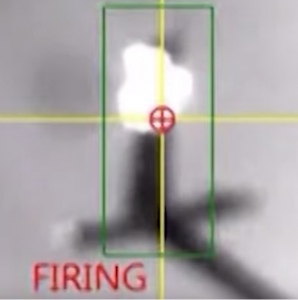
Source: (Drone being destroyed, 2022)
One thing is clear: The US Navy is serious about deploying LASERs and integrating them into the Aegis combat system. The options mentioned in the Lockheed Martin contract suggest that if the first two LASERs meet the navy’s requirements, it will exercise those options and deploy more LASERs onboard its ships. The US Army plans to field an even more powerful LASER weapon in the 250 to 300kilowatt range to protect combat troops against drones, artillery rockets, helicopters, and attack jets. According to Breaking Defense, “Less than three months after awarding a $130 million contract [to Lockheed/Dynetics] to build a 100-kilowatt [kW] LASER, the Army has decided to skip the 100-kW weapon and go straight for a much more powerful one in the 250–300 kW range. Unlike the original design, the higher power level could potentially shoot down incoming cruise missiles—plugging a glaring gap in US defenses against a Russia, China or Iran.” This article suggests the navy’s LASER weapon will be in roughly the same range, exceeding previous speculations. (Dynetics, 2019)
A SOLUTION WAITING FOR A CONFLICT
Initially, the scientific community viewed the invention of the LASER as a solution looking for a problem. It is reasonable to imagine it as a solution waiting for a conflict as a weapon. Here are the most compelling reasons why the author thinks the US Navy is eager to deploy LASERs on board ships: LASERs with sufficient power and integrated into the navy’s Aegis combat system have the potential to overcome a broad range of threats, from swarm attacks to carrier-killer missiles. LASERs are cost-effective, with a typical shot to destroy a drone costing less than a dollar in electricity. LASERs allow unlimited shots, requiring only the ship’s generator pump sufficient power. LASERs remove a war vessel’s major vulnerability by replacing conventional weapons that use gun powder, thus eliminating the need to store ammunition within the ship’s magazine. LASERs make it easier to hit a target since there is no need to calculate the trajectory, the windage, or the target’s movement. The LASER’s trajectory is flat, unaffected by windage, and travels at the speed of light, making even a hypersonic missile look as though it is standing still. The US Army’s reason for building an extremely high-power LASER is to address threats from “jet-powered cruise missiles—which fly lower, slower, and with more maneuverability have proliferated worldwide, even to high-end irregular forces like Iran-backed Hezbollah.” In addition, the Army would also accrue many of the same benefits cited for the navy’s LASER system.
LASER WEAPONS OF POTENTIAL ADVERSARIES
Let us examine the LASER weapons of the United States’ two most capable potential adversaries, China and Russia. We need to view both as potentially dangerous threats but for different reasons. China has an economy that can support the research and development necessary to develop LASER weapons. Additionally, China supports state-sponsored hacking of US intellectual property, including LASER weapons technology. We must take Russia seriously because it has nuclear parity with the United States. While Russia’s economy is weak, it is still modernizing its military. Like China, the Russians appear adept at hacking. (Monte, 2021)
China’s LASER weapon closely resembles the US Navy’s LaWS. According to Sina.com, China intends to deploy the weapon on land and at sea, including aboard its destroyers, as an alternative to the short-range surface-to-air missile. This last statement implies it has a range of about three miles. Beyond discussing potential applications, China provides no evidence of the LASER’s capabilities. Additional information indicates China is working on LASER weapons. In 2017 China released information about a land-mobile LASER weapon that successfully destroyed an unmanned aerial vehicle at a range of about a thousand feet. The Washington Free Beacon also reported, “China’s military is expected to deploy a LASER weapon capable of destroying or damaging US military satellites in low earth orbit in the next year [2020], the Pentagon’s Defense Intelligence Agency disclosed. In a report on space threats.” (Monte, 2021)
The US Defense Intelligence Agency’s January 3, 2019, report states, “Chinese leaders characterize China’s long-term military modernization program as essential to achieving great power status. Indeed, China is building a robust, lethal force with capabilities spanning the air, maritime, space, and information domains, which will enable China to impose its will in the region.” The last three words, “in the region,” are particularly significant. (Monte, 2021) A June 26, 2019, article in the New York Times reported, “China is an authoritarian nation that most likely seeks to displace American military dominance of the western Pacific. (NYT, 2019)
China is a nuclear power and may be inclined to use nuclear weapons if its communist-run government thought it might lose such a conflict. (Monte, 2021) In 2018 the United States and China were each other’s largest trading partners. According to the Office of the United States Trade Representative’s website, “US goods and services trade with China totaled an estimated $737.1 billion in 2018. Exports were $179.3 billion; imports were $557.9 billion. The US goods and services trade deficit with China was $378.6 billion in 2018.” (Monte, 2021)
These salient facts regarding China’s LASER thrusts, its geopolitical goals, and its trade with the United States place its pursuit of LASER weapons in the broader context of its national goal to dominate the Asia-Pacific region. They also delineate the United States’ complexities as it attempts to confront China. (Monte, 2021) Russia’s interest in LASER weapons dates to the Soviet Union’s construction of a ground-based LASER facility in 1987, a decade ahead of the development of the US ground-based LASER at Lawrence Livermore National Laboratory in 1997. On August 19, 1989, the New York Times reported, “The DoD has pointed in particular to a facility at Sary Shagan in Kazakhstan, which was alleged to contain a LASER weapon that ‘could be used in an anti-satellite role today and possibly a ballistic missile defense role in the future.’” Upon visiting the facility in 1989 as part of the Soviet glasnost policy of openness, the reporters instead found relatively weak LASERs whose “beams were 1,000 times less powerful than those of the Mid-Infrared Chemical LASER at the Strategic Defense Initiative’s White Sands [Proving Ground in New Mexico].” (Monte, 2021) If the Soviets had revealed a weapons-grade LASER at the facility, the Times would assuredly have written an article suggesting that the Soviets could attack US satellites and missiles, information that would have sent shock waves through the Pentagon.
Furthermore, during the same week as the reporters’ visit, the Soviets demonstrated “to American experts a high-power gas LASER” at another facility. The demonstration was again part of the Soviet glasnost policy and is proof positive the Soviets had a weapons-grade LASER. These facts raise a question: Were the Soviets being open but misleading simultaneously? During the late 1980s, the US government was deeply concerned regarding the Soviet’s LASER capabilities. The New York Times reported in 1987 that “Secretary of Defense Caspar W. Weinberger [under President Reagan] recently has warned of powerful new Soviet LASERs on the horizon. ‘We expect them to test ground-based LASERs for defense against ballistic missiles in the next three years.’” Weinberger’s statement is clear evidence the US government worried the “balance of terror” would tilt in favor of the Soviets. When the USSR collapsed, Russia inherited its technology. It makes sense that the Russians would continue to develop the LASER technology handed down from the Soviet era. In 2018 Russia tested an anti-ballistic missile interceptor at the site.
The days of glasnost are over. Today, secrecy surrounds the Sary Shagan facility, and news regarding the site is sparse. On March 1, 2018, Russian President Vladimir Putin announced the existence of a new LASER weapon during his State of the Nation address: “We have achieved significant progress in LASER weapons. It is not just a concept or a plan anymore. It is not even in the early production stages. Since last year, our troops have been armed with LASER weapons.”
Additionally, Newsweek reported, “Accompanying Putin’s March 1 speech, in which he revealed an array of new and advanced weapons, was a short video showing what appeared to be a truck-mounted LASER system. The ministry entitled the clip ‘Combat LASER Complex,’ but Putin said at the time that he was not ready to reveal the weapon’s name or any other details.” The LASER is similar in appearance to the US Navy’s LASER, which is about all we know. Its capabilities and purpose remain classified. Both China and Russia typically exaggerate their weapons’ capabilities, and both knew the United States was fielding LASER weapons with demonstrated lethality. (Monte, 2021) Their respective leaders were under pressure to show their militaries deployed similar weapons. (Monte, 2021) They offered no evidence demonstrating their LASERs can down drones, sink small boats, or compensate for atmospheric conditions. (Monte, 2021) However, we should not discount their military capabilities. Both countries are working on developing LASER weapons. As previously stated, relative momentum is critical in terms of military capability. Short of conflict, we have evidence that our adversaries are using directed-energy weapons, such as microwave weapons, covertly against the United States. (Monte, 2021)
OTHER CONSIDERATIONS
We must look at what will make the most powerful LASER. It may be obvious; however, focusing as much energy in one spot for an appropriate amount of time causing disruption to the material or target will be extremely important. Taking a step back, many of the uses for LASERs require Low power output, mainly due to heat buildup. Heat buildup on computer components is detrimental if not dealt with by some cooling.
Even though LASERs are directional and have coherence, they cannot maintain coherence for an indefinite amount of time and space in an atmosphere. Considering the atmosphere is important because LASER energy interacts with molecules in the atmosphere, thus reducing its effectiveness. The components that make up how long a LASER beam will hang together and what power can be delivered to the targeted material are a function of the Type of LASER, Power, and Design.
The LASER that Maiman initially discovered was a Ruby LASER that used Ruby crystal to develop an oscillation and expel photons of Red LASER light. There are three main types of LASER design in practicality—solid-state LASERs, like Maiman’s. Gas LASERs tend to be more uniform and develop less loss in energy, and the resonator can be larger to allow for larger LASER output. However, for weapons-grade, fiber optic LASERs offer the best possible solution.
A fiber optic LASER allows for the greatest amount of LASER output. Regarding design, refraction is how the LASER light will change direction as it transverses from one side of a lens to where it exists. Thin lens coatings are a very involved science based on the chemistry of the coatings applied to the lens. The lens is an important part of the design to establish the coherence of the emitted LASER energy. This is because a lens can affect the Laser’s refractive index with lens coatings. A LASER beam begins to hang together at its focal point along its focal length. The focal length is known as the Raleigh Range Zr. The Raleigh Range is given by: Zr = πW2/λ. W = D/3sqrt2 gives the beam radius.
Conceptually, LASER design is relatively simple and only consists of three components:
- a medium. This is the source of light within a LASER. It can be composed of a solid, gas, or liquid. The medium is typically confined in a tube.
- An energy source. The energy source can be an electrical current or another LASER.
- A feedback element. This component takes the output from the LASER medium and routes it back into the system. (This has the effect of ramping up the energy in the system) The feedback element often consists of two mirrors that confine the LASER light within the LASER medium. In practice, one mirror is partially silvered, meaning the silver coating is less dense and can allow the most powerful LASER light to escape. These components work together to form a LASER beam.
CONCLUSION
LASERS represent a potent weapon. LASERS can be attached to drones to attack surface or air targets. On the flip side, LASERS can be used to detect and eradicate drone threats.
Bibliography
Airforce Technology. (2022, April 7). usaf-lockheed-athena-laser-weapon/. Retrieved from www.airforce-technology.com: https://www.airforce-technology.com/news/usaf-lockheed-athena-laser-weapon/
Arkin, W. M. ( 1 May 1995). U.S. Blinding Laser Weapons. London: Human Rights Watch. Retrieved from https://www.refworld.org/docid/3ae6a7cf10.html
Atmospheric influences. (2022, April 7). Retrieved from www.youtube.com: Figure 7: Atmospheric influence https://www.youtube.com/watch?v=w6tkL1w27Js&t=35s
Can a LASER pointer bring down a drone? (2022, April 7). Retrieved from www.droneblog.com/laser-pointer/: https://www.droneblog.com/laser-pointer/
countering-the-uas-challenge. (2022, April 7). Retrieved from www.microwavejournal.com/: https://www.microwavejournal.com/articles/29337-countering-the-uas-challenge
Drone being destroyed. (2022, April 7). Retrieved from www.youtube.com: https://www.youtube.com/watch?v=tyUh_xSjvXQ
Dynetics. (2019, May 15). team-dynetics-wins-130-million-100kw-class-high-energy-laser-contract-for-us-army. Retrieved from www.dynetics.com: https://www.dynetics.com/newsroom/news/2019/team-dynetics-wins-130-million-100kw-class-high-energy-laser-contract-for-us-army
HEL High Energy LASER USS Ponce. (2022, April 7). Retrieved from https://d1ldvf68ux039x.cloudfront.net/thumbs/photos/1707/3622264/1000w_q95.jpg: https://d1ldvf68ux039x.cloudfront.net/thumbs/photos/1707/3622264/1000w_q95.jpg
Kurzweil, R. (2020, July 13). top-20-predictions-from-kurzweil-future-technologies. Retrieved from www.epicheroes.com/: https://www.epicheroes.com/2020/07/13/top-20-predictions-from-kurzweil-future-technologies/
Laser Coherence. (2022, April 7). Retrieved from images.search.yahoo.com: https://images.search.yahoo.com/yhs/search?p=picture+of+LASER+coherence&fr=yhs-mnet-001&type=type9045647-spa-6246-84501&hspart=mnet&hsimp=yhs-001&imgurl=http%3A%2F%2Fallthingsd.com%2Ffiles%2F2013%2F07%2Fcoherence.jpg#id=3&iurl=http%3A%2F%2Fallthingsd.com%
LASER platform mounted on Boeing 747 . (2022, April 7). Retrieved from www.youtube.com/: https://www.youtube.com/watch?v=w6tkL1w27Js&t=35s
LASER Sight on M-4. (2022, April 7). Retrieved from https://ind5.ccio.co/: https://ind5.ccio.co/k6/YB/u1/250090585527361016sThEIXYBc.jpg
LASER Testing. (2022, April 7). Retrieved from www.youtube.com/: https://www.youtube.com/watch?v=w6tkL1w27Js&t=35s
LASER weapon Destroying UAV. (2022, April 7). Retrieved from www.youtube.com: https://www.youtube.com/watch?v=w6tkL1w27Js&t=35s
laser-pointers-blind-pilots. (2015, July 7). Retrieved from paul.is-a-geek.org: https://paul.is-a-geek.org/2015/07/laser-pointers-blind-pilots/
Monte, L. A. (2021). War at the speed of light. (P. E. Central, Ed.) Lincoln, Nebraska, USA: Potomac Books, 2021. Retrieved from http://ebookcentral.proquest.com/lib/ksu/detail.action?docID=6460626
Multilateral-Weapons-Protocol-IV. (2019, February 9). Retrieved from https://www.state.gov/wp-content/uploads/2019/02/09-721.2-Multilateral-Weapons-Protocol-IV.pdf: https://www.state.gov/wp-content/uploads/2019/02/09-721.2-Multilateral-Weapons-Protocol-IV.pdf
Nichols, R., & al., e. (2020). Counter Unmanned Aircraft Systems Technologies and Operations. Manhattan, KS: new prairie press #31.
Nielsen, P. E. (1994). Effects of Directed Energy Weapons. Dayton, OH: USAF.
Nielson, P. E. (1994). Laser Interaction with Matter. In P. E. Nielson, Effects of Directed Energy Weapons (pp. 88-89). Coppell.
NYT. (2019, June 26). united-states-china-conflict.html. Retrieved from www.nytimes.com: https://www.nytimes.com/2019/06/26/world/asia/united-states-china-conflict.html
Rafael Drome Dome – c-uas-counter-unmanned-aircraft-systems/. (2022, April 7). Retrieved from www.rafael.co.il: https://www.rafael.co.il/worlds/air-missile-defense/c-uas-counter-unmanned-aircraft-systems/raytheon-drone-killing-laser. (2022, April 7). Retrieved from www.assignmentacer.com: https://www.assignmentacer.com/raytheon-drone-killing-laser/
Townes. (2007, June 7). Obituary Theodore H. Maiman. Nature, pp. 654-654. doi:https://doi.org/10.1038/44765a
Townes, C. H. (2004, November 10). Making Waves. Nature 432, p. 153. doi:https://doi-org.er.lib.k-state.edu/10.1038/432153a
USN. (2022, April 7). navy-unveils-next-generation-ddgx-warship-concept-with-hypersonic-missiles-LASERs. Retrieved from www.microwavejournal.com/: https://www.microwavejournal.com/articles/37513-navy-unveils-next-generation-ddgx-warship-concept-with-hypersonic-missiles-LASERs
USN. (2022, April 7). us-navy-successfully-test-fires-high-energy-laser-weapon-system. Retrieved from www.foxnews.com: https://www.foxnews.com/us/us-navy-successfully-test-fires-high-energy-laser-weapon-system
Will-a-Laser-Pointer-Bring-Down-a-Drone-Answered. (2022, January 1). Retrieved from www.droneblog.com/: https://www.droneblog.com/wp-content/uploads/2022/01/Will-a-Laser-Pointer-Bring-Down-a-Drone-Answered-735×294.jpg.webp
Endnotes
[1] These are just a smattering of the CUAS systems available. The authors do not endorse any product. The CUASS subject is covered in detail in our textbook: (Nichols & al., 2020)
[2] There are many uses for LASERS, both commercially and militarily. The purpose of this chapter is not a history lesson but a look at its potential use as a weapon attached to UAS. Consult any standard textbook for the diversified uses of LASERS.
[3] There has been a vicious legal battle for LASER ownership involving Einstein, Towns, Gordon, Zeiger, Weber, Basov, and Prokhorov. Consult (Monte, 2021) for the historical implications.
[4] If this analysis is correct, it suggests the prospect of having superior conventional weapons trumps ethical concerns.
[5] SME MAI observation 04072022.
[6] Nielson (Nielson 1994) is the expert on using LASERS as DEW. A detailed mathematical and physical analysis may be found in his textbook. Recommended.
[7] LaWS = LASER Weapon System such as the USN advanced LaWS. See: (USN, 2022)
[8] Left to the student for fun.
[9] See Chapter 8 for definitions.
[10] Refer to p 191 of (Nielsen, 1994) for Figures 3-76. “Significant Propagation and Target Interaction Effects, Intensity ( W/cm2 ) by Pulse (sec). These will bring the seven summary points into focus.

